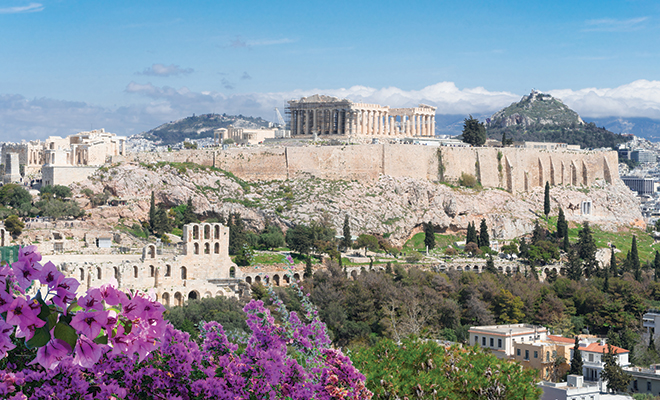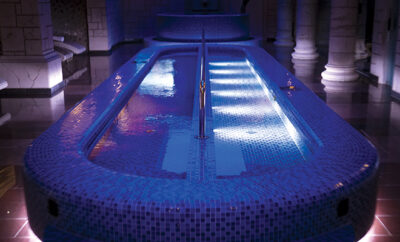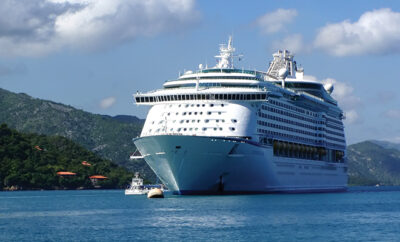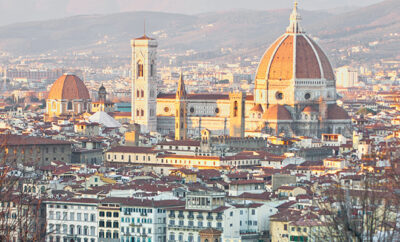
Trekking through Greece
Mycenaean ruins, abandoned monasteries, kouroi, spectacular vistas and challenging mountain trails. Add the warmth of a local hotel and its owners, a seaside town with pebbled beaches, and it’s a soul-satisfying vacation.
Seasoned travelers Mary Jane Roberts and Nan Burgess have walked the Pyrenees, Italian mountains and cities and the slopes of Capri. June’s trip to the Peloponnese and Cyclades islands in the Aegean Sea was a mélange of ancient and modern, simplicity and luxury.
“We were based in the fishing village of Tyros, staying in the Oceanis hotel on the seafront near the harbor,” Mary Jane describes. “The accommodations were simple but the view was incredible, and the owners, Tasos and Roula, met us each morning with fresh bread, local jams, honey, eggs, seasonal fruit and, of course, Greek yogurt.”
The tour team, Greece on Foot, is led by Wendy Copage, a British expatriate who has lived in the area for 20 years. “Wendy is a true Grecophile. She loves the people, the environment, and she makes sure everything her company does benefits the local economy and ecology. She also wants her guests to understand and learn about where they are,” Mary Jane affirms. “For dinner one night, we were invited to the home of a local team member, and we had a very personal glimpse into how the Greek people are taking care of their families after the country’s economic crisis. Ecological tourism is important for this region. One team member is living away from his family to support them by working in this industry instead of in his family’s business.”
Walking tours are geared to the guests’ abilities and to the current weather conditions. “The slopes of Mt. Parnon are challenging and some are very remote. As we trekked, there were always surprises,” Nan notes. “We would encounter tiny villages and abandoned monasteries from the 13th and 14th centuries. They are spotlessly clean; evidently, they’re maintained by families who live nearby and preserve them.”
“Wendy is very sensitive to the hiking conditions,” Mary Jane recalls, noting the recent fires in Greece that have devastated many areas. “One day’s hike was switched due to dry conditions on the planned route. She was concerned that we would be isolated and trapped by fire.”
The second leg of the trek was guided by a major international tour company. “We were based in Athens and took ferries to the Cyclades islands—Tinos, Naxos and Santorini. While our group in Tyros included just three, this was a slightly larger yet still congenial group of 15.
“Exploring Athens, we occasionally encountered a home that was being renovated,” Nan describes. “You might see a courtyard covered with plexiglass; Greek law requires that if a homeowner uncovers ruins or something of archaeological interest, they have to check with the Department of Antiquities for permission to continue!”
Each island revealed surprises. “We reached the top of a hill on Tinos near the village of Tarambados, and in the valley below, everywhere you looked were dovecotes! Some are not functional, but some are, and they’re built in an architectural style that’s distinctive to Tinos.” It’s believed that the Venetians introduced systematic breeding of pigeons centuries ago for meat and droppings, a fertilizer. The dovecotes are strikingly beautiful; builders used local slate to form unusual decorations on the building facades, such as rhomboids, triangles, suns and cypress trees. “The artistry and setting were breathtaking,” Mary Jane notes.
“Outside one village on Tinos, we encountered a tiny store, much like a mall kiosk, with no one there,” Nan recalls. “It had water, coffee, filters, and you made your own coffee, washed your dishware, and put your euros in the honor box. We have found during these trips that travelers are leaving the environment the way they find it and behaving in the ways they would choose to be treated.”
Naxos is the largest island in the Cyclades. “We hiked to the top of Mt. Zos, the mountain of Zeus. It wasn’t unusual to see broken statuary lying by the trail.” These are kouroi, in the singular, kouros, a Greek word meaning “youth” and describing statues of young men. Around 600 BCE, these statues were being created in the marble quarries and transported down the slopes; it’s believed that the kouroi hikers find were broken on the way down and abandoned.
Santorini was touristy, but gorgeous,” says Mary Jane. “Since it’s a volcanic island, the rim above the sea is developed, but the back side holds the Bronze Age city of Akrotiri, under excavation for 150 years. It was buried under a volcanic eruption about 1657 BCE. The interesting thing is that no uninterred remains have been found; archaeologists speculate that the inhabitants knew the eruption was coming and evacuated.”
What’s next? The friends laugh. “There’s a milestone birthday coming up. It’s guaranteed to be noteworthy!” ■







